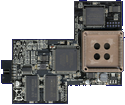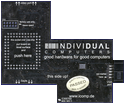Search Result
3 expansions found
Company Individual Computers, Germany | Date 2008/2009 | Amiga A1200, A4000, CD32 | Interface Lisa chip |
- flicker-fixer
- with a maximum input pixel clock of 28 MHz, all Amiga video modes up to Super Hires are supported and flicker-fixed (with the exception of the A2024 mode)
- picture refresh rate of at least 60 Hz for all screen modes, resulting in a maximum output pixel clock of 71 MHz
- 24 bit color support (16.7 million colors)
- supports interlaced and progressive scan input modes
- output modes are always progressive scan
- two output modes can be chosen:
- Async mode: output pixel clock of Amiga modes are multiplied 2.5 times
- Vertical Sync mode: exact double of Amiga mode pixel clock (eliminates tearing effects)
- clips only onto the Lisa chip on motherboard, no soldering required
- gets power and all signals from this chip
- sync signals are derived from the inter-chip communication of the AGA chipset
- HD15 VGA connector
- supports border blanking
- 16 megabyte SDRAM
- SDRAM is single-ported, thus reading and writing is decoupled by two FIFO buffers and a dual-port SDRAM controller running at 111 MHz
- only 12 MB are used, 4 MB stay free
- memory layout of 2048x2048 pixels (= maximum resolution)
- compatible to Genlocks
- no passthrough mode (all resolutions are flicker-fixed)
- FPGA based design with FlashROM
- Emergency Mode (emergency disk needed) in case a FlashROM update went wrong
- low heat dissipation due to 2.5V/3.3V design (only the voltage regulator is 5V)
- boot screen, shown for a pre-defined time - in case important information is displayed (e.g. Guru / Error Screen, Early Startup Menu), this time is reduced
- no driver needed, however additional screenmodes are supported:
- HighGFX (1024×786)
- HD720 (1280×720)
- Indivision AGA 1200
- cutouts in the board allow installation of other internal A1200 components like IDE-Fix Express and the Lyra 1200 keyboard adaptor - tight design, so boards may touch on certain A1200 board revisions
- first revision boards were prone to snapping from the Lisa socket, so later revisions had the socket on the Indivision board machine finished
- Indivision AGA 4000
- this is a follow-up design to the Indivision AGA 1200, offering the same features while having a different board layout to fit in A4000D and CD32
- 10nF capacitors have been added to the PLLs
- two (instead of one) TTL drivers for the VGA Sync wires
- prototype board is white, the final version has a blue PCB
Company Individual Computers, Germany | Date 2012/2013 | Amiga A1200, A4000T, A4000, CD32 | Interface Lisa chip |
- flicker-fixer
- all Amiga video modes up to Super Hires are supported and flicker-fixed (with the exception of the A2024 mode)
- picture refresh rate of at least 60 Hz for all screen modes, resulting in a maximum output pixel clock of 71 MHz
- 24 bit color support (16.7 million colors)
- supports interlaced and progressive scan input modes
- output modes are always progressive scan
- two output modes can be chosen:
- Async mode: output pixel clock of Amiga modes are multiplied 2.5 times
- Vertical Sync mode: exact double of Amiga mode pixel clock (eliminates tearing effects)
- clips only onto the Lisa chip on motherboard, no soldering required
- gets power and all signals from this chip
- sync signals are derived from the inter-chip communication of the AGA chipset
- DVI-I connector
- supports border blanking
- 16 megabyte SDRAM
- SDRAM is single-ported, thus reading and writing is decoupled by two FIFO buffers and a dual-port SDRAM controller running at 111 MHz
- only 12 MB are used, 4 MB stay free
- memory layout of 2048x2048 pixels (= maximum resolution)
- compatible to Genlocks
- no passthrough mode (all resolutions are flicker-fixed)
- FPGA based design with FlashROM
- Emergency Mode (emergency disk needed) in case a FlashROM update went wrong
- low heat dissipation due to 2.5V/3.3V design (only the voltage regulator is 5V)
- boot screen, shown for a pre-defined time - in case important information is displayed (e.g. Guru / Error Screen, Early Startup Menu), this time is reduced
- no driver needed, however additional screenmodes are supported:
- HighGFX (1024×786)
- HD720 (1280×720)
- Xtreme (1280×1024)
- SuperPlus (800×600)
- config tool provided to update flash memory and make adjustments to the output
- the socket on the board had to be machined to fit properly on the Lisa chip
- compared to the predecessor, the board features a faster FPGA, faster memory and more flexible pixel clocks - however the main features stay the same
- Indivision AGA MK2 1200 / A4000T (2012)
- DVI connector is located on a small PCB
- Indivision AGA MK2 4000 / CD32 (2012)
- DVI connector is located on a small PCB
- has a different board layout to fit in A4000D and CD32, but has the same features as Indivision AGA MK2 1200 / A4000T
- Indivision AGA MK2cr 1200 / A4000T (2013)
- cost reduced version:
- the components from the auxiliary PCB were moved to the Indivision board
- custom made DVI-I connector (molded type) connects to the board
- doesn't fit into the A4000T without modification: due to the changed connector for the DVI ouput, the board interferes with the electrolytic capacitor CE164C in the A4000T - this has to be replaced by a lower profile ceramic type to be able to fit the board
- custom tooling for the socket pins results in a firmer hold on the Lisa chip
Company X-Pert Computer Services / Viona Development, Germany | Date 1990 | Amiga A2000, A3000, A4000 | Interface Zorro II | Autoconfig ID 2117 / 1,2 |
- RTG graphics card
- Inmos IMS G300C (85, 110 or 135 MHz) programmable RAMDAC and sync generator
- no blitter, line drawing engine, or other general purpose graphics processing capability
- Visiona Paint: 2 MB 20 ns VRAM in 16 ZIP sockets
- Visiona Paint+: 4 MB 20 ns VRAM in 32 ZIP sockets
- screen modes
- maximum resolution is only limited by the amount of VRAM installed
- 24/32 bit: up to 1024×1024
- 8 bit: up to 2048×2048
- 2 bit: up to 4096×4096
- 1 bit: up to 8192×4096
- the resolutions above need 4 MB VRAM - with 2 MB VRAM, the maximum resolution is limited
- maximum horizontal frequency: 80 kHz
- resolutions above 1600×1280 flicker badly
- notes
- Visiona Paint can be converted to a Visiona Paint+ by adding 16 RAM chips and a new control PAL
- the VRAM uses 2 resp. 4 MB in the Zorro II address space:
- limits Zorro II RAM expansions to 6 resp. 4 MB
- the VRAM can be used by the Amiga as memory expansion using Addmem program (Visiona library must not be activated)
- content of the Video RAM can be changed by the CPU and the Video Controller (which accesses the Video RAM with a DMA controller)
- two separate oscillators for PAL and NTSC signals - two additional sockets for eg. SECAM
- 15 pin VGA connector
- five HF-PCB connectors
- supports several Sync options:
- output: separate H-Sync/V-Sync, Composite Sync on H-Sync, Sync-on-Green
- input: external synchronization (on H-Sync) with a TBC possible (needs small hardware expansion)
- EGS driver
- the Visiona, the GVP EGS-110/24 and EGS-28/24 Spectrum were all designed by Hendrik Horak
- DIP switch settings
| Jumper | Description | ON | OFF |
| 1 | Amount of Video RAM | 4 MB | 2 MB |
| 2 | ROM selection | selected | deselected |
| 3 - 6 | reserved | - | - |
| 7 | Video Standard | NTSC | PAL |
| 8 | Interlace setting | Interlace on | Interlace off |
| 9 | not used | - | - |
- Visiona.pdf
Bedienungsanleitung / german user manual
1350 kB
- Visiona_Demos-1.dms
Demos Disk 1
471 kB - Visiona_Demos-2.dms
Demos Disk 2
411 kB - Visiona_Demos-3.dms
Demos Disk 3
589 kB - Visiona_Demos-4.dms
Demos Disk 4
682 kB - Visiona_Demos-5.dms
Demos Disk 5
778 kB - Visiona_Imagemaster.dms
ImageMaster Disk
22 kB - Visiona_Libs.dms
Libs Disk
126 kB - Visiona_System-10.dms
System Disk v1.0
311 kB - Visiona_System-134.dms
System Disk v1.34
310 kB - Visiona_Tools-13.dms
Tools Disk v1.3
317 kB - Visiona_Tools-134.dms
Tools Disk v1.34
300 kB - Visiona_TV-Paint_Demo-18.dms
TV-Paint Demo v1.8
220 kB
 Amiga Hardware Database
Amiga Hardware Database










